Genz Protest Nepal : A Fight for Justice, Truth, and a Better Future
9th September 2025

Nepal is living through a moment of history. On 8 September 2025, a decision by the government to ban more than two dozen social media platforms sparked what is now recognized as one of the most powerful youth-led movements in the country’s democratic journey.
But to call this simply a “social media protest” would be a grave mistake. The ban was only the spark. The fire was already there fed by corruption, deepening inequality, nepotism, and a loss of trust in leadership.
The Gen Z protest has already claimed at least 19 young people and hundreds more injured. It has brought down ministers, shaken the corridors of power, and lit a flame of resistance that cannot easily be extinguished.
This blog is written in solidarity with Nepal’s young people—those who lost their lives, those who continue to risk theirs, and those who refuse to be silenced.
How it began: The social media blackout
On the morning of 4 September, people across Nepal found themselves cut off from their digital lifelines. Around 26 platforms—including WhatsApp, Facebook, Instagram, YouTube, and X—were suddenly blocked.
The government claimed it was about regulation: forcing tech companies to register locally, cracking down on scams, and monitoring misuse. But to millions of young Nepalis, this was censorship.
Social media isn’t just entertainment for Gen Z—it’s their market, their stage, their university, their protest square. Cutting it off overnight felt like cutting off oxygen.
By the 9am of 8 september, students and young professionals had already begun gathering in Kathmandu. Placards read: “We want freedom, not control.” Slogans erupted: “Shut down corruption, not social media.”
What began as frustration over connectivity became a direct confrontation with the system itself.
The streets fill with fire
The scenes in the capital grew larger each hour. Crowds pressed against barricades near Singha Durbar and Parliament House, waving flags, chanting, and demanding the government roll back the ban.
The state’s response was swift and harsh.
- Tear gas canisters were fired into crowds.
- Water cannons sprayed teenagers who had no weapons but placards.
- Rubber bullets struck protesters in their legs, arms, and chests.
- Worst of all, live bullets were fired into crowds of unarmed youth.
Hospitals in Kathmandu were soon filled with bodies—some lifeless, some critically injured. Ambulances ran endlessly. Volunteers rushed to donate blood.
By evening, the death toll had already begun to rise. Families wailed outside hospital gates. Students lit candles on the sidewalks.
The cost in lives: 19 killed, hundreds injured
The verified toll is devastating:
- 19 young people killed—most of them students, barely in their twenties.
- Over 200 were injured by gunfire, tear gas, and police batons. Some reports suggest as many as 347 treated across hospitals.
- Dozens remain in critical condition, and many families still search for missing loved ones.
Behind each number is a name, a face, a story of a dream cut short.
One young man was preparing for his engineering finals. Another was the only son of a single mother. A girl who had just completed her SEE exams was shot while handing water bottles to protesters.
These deaths are not statistics, they are sacrifices.
Ministers forced to resign
As outrage swept across the nation, the government tried to control the fire by offering resignations:
- Ramesh Lekhak – Home Minister
- Resigned citing “moral responsibility” after being directly blamed for ordering excessive force.
- Ram Nath Adhikari – Agriculture Minister
- Stepped down amid public fury, though his ministry had no direct link to the crackdown. His resignation symbolized growing cracks within the ruling coalition.
- Pradip Paudel – Health Minister
- Resigned after hospitals were overwhelmed and his ministry was accused of failing to provide adequate emergency care.
But for protesters, these resignations were only a start. The real target was deeper: an entire culture of corruption and impunity.
The corrupt elephant in the room
Gen Z protesters made one thing clear: This is not just about the internet.
For decades, Nepal has been plagued by corruption scandals:
- Contracts are awarded to relatives and cronies.
- Public funds siphoned for private gain.
- Infrastructure projects left incomplete after billions disappeared.
- Politicians’ families flaunting wealth while ordinary citizens struggle for jobs.
The nepo-babies of Nepal’s politics have become living symbols of this injustice. While ordinary youth fight for basic employment and education, the children of minister’s post pictures from Europe, Australia, and the Gulf. They flash designer brands, luxury cars, and exotic vacations on social media—wealth far beyond the salaries of their parents.
To young Nepalis, these images are not harmless. They are daggers. They represent a system that denies them a future while rewarding the privileged few.
Verified facts vs. Allegations
To remain clear and fair, here’s where things stand:
Verified facts:
- 19 killed, more than 200 injured.
- Tear gas, water cannons, rubber bullets, and live rounds used.
- Social media ban was imposed, then rolled back within 24 hours.
- Army deployed, curfews enforced.
- Three ministers resigned.
Allegations circulating widely on social media:
- The security forces raided private homes and fired bullets inside.
- That women protesters were assaulted during the crackdown.
- That ministers’ children fund their luxury lifestyles through corruption.
These allegations are unproven, but their power is undeniable. They circulate because they resonate with a deeper truth Nepalis already feel that the state is corrupt and unaccountable.
A movement larger than fear
Despite bullets, fear did not win.
Young people kept gathering. In the evenings, they held vigils for the dead. Neighbors brought food and water. Families of the injured were supported by strangers.
Symbols emerged too: the Straw Hat flag from One Piece was waved proudly, representing rebellion, freedom, and unity.
Placards carried messages that cut to the bone:
- “Our friends are not coming back, but our fight goes on.”
- “We don’t need your resignations—we need justice.”
- “End corruption or end your government.”
The protest turned into cultural movements, songs, street art, and slogans spread across cities even faster than the government could censor them.
What Gen Z wants
The demands of protesters are consistent:
- Justice for the dead — independent investigation into who ordered the shootings.
- Accountability for corruption — transparency in wealth of ministers and their families.
- Protection of digital rights — no more blanket bans on social platforms.
- End to nepotism — equal opportunity in education, jobs, and governance.
This is not a protest of anger alone. It is a protest of vision. Gen Z is not simply tearing down; they are imagining a new Nepal.
The battle for the nation’s soul
Nepal’s leadership hoped that restoring social media access would end the anger. But it has not. Because this protest was never only about apps.
It is about decades of stolen futures. About how a handful of families have treated the state like their inheritance. About how ordinary Nepalis are asked to sacrifice while leaders’ children jet-set across the world.
The protesters have declared it clearly: Nepal belongs to its people, not to corrupt elites.
In support of Gen Z — a final word
This blog stands with the youth of Nepal. Their courage in the face of bullets is unmatched. Their clarity in calling out corruption is undeniable.
Yes, 19 are dead. Hundreds are injured. Families are grieving. But something new has also been born: a generation unafraid to demand accountability.
The resignations of three ministers are not enough. The lifting of the ban is not enough. Only justice, transparency, and reform will honor the lives lost.
The Gen Z protest is not a rebellion to be crushed—it is a rebirth to be embraced.
Nepal’s leaders must listen. The world must watch. And the people, especially the young, keep pushing, because they have already shown the country one undeniable truth:
You can ban the apps, you can fire the bullets, but you cannot kill a generation’s demand for justice.
Recent From Blogs

7th October 2025

27th September 2025

25th September 2025

22nd September 2025

20th September 2025

17th September 2025

15th September 2025

13th September 2025

11th September 2025





